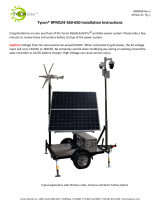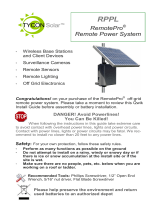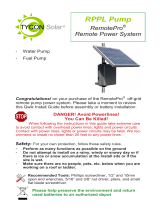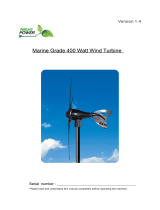Page is loading ...

Page 1
A. NOTICE
1. This information is believed to be reliable; however, We assume no
responsibility for inaccuracies or omissions. The user of this information and
product assumes full responsibility and risk.
2. All specifications are subject to change without notice.
3. Wind turbines must be installed following the guidelines of local regulations.
B. SAFETY PRECAUTIONS (Important)
1. Safety must be the primary concern as you plan the location, installation and
operation. Please be aware of electrical, mechanical and blade hazards.
2. DO NOT install the turbine where anyone could approach the blades.
3. Use common sense and be careful.
4. Select the correct wire size, and the correct fuse size.
5. When installing, please make sure that the wind turbine is disconnected from
the batteries.
6. Do not let the blades spin freely until the turbine is mounted on the pole.
7. Never approach the turbine during operation.
8. The edges of the blades are very sharp, please be careful.
C. About BreezePro®
1. This wind turbine has an embedded PWM charge controller with dump load.
It controls battery charging and protects the wind turbine in high winds.
2. This wind turbine is designed to charge 12V or 24V Lead-Acid battery,
specifically AGM or GEL sealed lead acid batteries.
It is 12V/24V auto select. It can only work with 12V or 24V battery. Please DO
NOT connect it to other battery voltages.
3. When connecting to the battery, please make sure that:
the RED wire (+) of the wind turbine connects to battery V+ (positive);
the BLUE wire (-) of the wind turbine connects to battery V- (negative).
4. Never allow a short between red and blue wires when the turbine is rotating.
5. Incorrect battery voltage or incorrect wire connection may damage the wind
BreezePro®
TPW-400DT 12/24V 400W Wind Turbine
User Guide

Page 2
turbine internal controller, and these are not covered by the warranty.
D. Package content and specification
D.1 Package Contents
Figure 1: Package list
BreezePro® is shipped partially disassembled. Please compare the parts shown
above to ensure that all necessary parts are included.
1
Mainbody
1
Fastener
Pcs
2
Hub
1
M14 Nut
1
for Hub
3
Nose Cone
1
Φ2.5 Cotter Pin
1
for Hub
4
Blade
6
Φ6*25 Screw
12
for Blades
5
Tail Vane
1
Φ6*20 Screw
3
for Tail Vane
6
Manual
1
M6 Gasket
3
for Tail Vane
M6 Nut (Nyloc)
15 + 2(spare)
for Blades & Tail
7
Fastener & Tools
→
5mm Hex Key
1
D.2 Specification
Rotor Diameter
1.2M
Net Weight
7.8Kg
Cut-in Wind Speed
2.1M/S
Rated Power
250W
Max Power
400W
Pole Dimensions
Inner Diameter 41mm
Package Weight
9.5Kg
Figure 2: Specification

Page 3
E.Prepare for install
E.1 The following general tools may be required for installing: Multi-meter
Wrench or spanner, Soldering iron, Screw driver, Heat shrink or electrical tape
E.2 Pole or Mast
1. BreezePro® is designed to mount to an aluminum or steel tube with an
inside diameter of 41mm. An inside diameter 41mm (1.6" or 15/8") steel
pole is readily available (water pipe or scaffold tube). Please do not use
plastic pipe.
2. A suitable mounting pole can be erected using a 6 meter galvanized pipe
supported by 3 or 4 guy wires (Refer to Figure 5).
3. Make sure a minimum 50mm clearance is provided between the blade tips
and any obstructions (Refer to Figure 3).
4. Mark and centre-punch two positions diametrically opposite, at 90° to the
pipe seam, 20mm from top of the pipe (Refer to Figure 4).
Then drill two 12mm diameter holes.
Figure 4: Mounting holes in pipe Figure 5: Mounting using guy wires
E.3 Wire
If the cross section area of the wires is NOT sufficient, the wires will heat up
and could create a fire hazard. Please choose the right size of wire.
Minimum Wire Size (X-Section Area):
Distance From Batteries to Turbine
0-10M
10-20M
20-30M
30-50M
Wire X-Section Area for 12V Battery
12AWG
10AWG
9AWG
8AWG
Wire X-Section Area for 24V battery
14AWG
12AWG
10AWG
9AWG
Figure 3: The clearance between the blade and pole

Page 4
F. Installation
F.1 Please follow these precautions during the installation:
1. THINK SAFETY! Have someone available to help when installing.
2. Disconnect batteries from turbine.
3. Be careful not to pinch the wires when attaching the turbine to pole.
F.2 Step-By-Step Instructions
F.2.1 Connect the wires and mount the turbine
1. Run the 2 wires from the battery location, through the pole to the top of it.
DO NOT connect the wires to the battery until everything has been completed.
Strip the insulation back from each side of wires. Mark both ends of the wires
with tape to identify the polarity: Red = Positive (+); Blue = Negative (-).
CAUTION: If you are uncertain of the polarity of the wires, simply spin the rotor
shaft clockwise and measure the voltage direction with a volt meter.
2. Connect the Red (+) and Blue (-) wires from the wind turbine to the wires from
the battery location. Insulate the connections using either heat shrink tubing
or a quality electrical tape or wire nuts.
3. Once the wires are attached to the BreezePro®, gently pull the wires down
through the mount pole sliding the yaw shaft into the pipe. Slide the yaw shaft
down inside the end of the pole carefully, so as not to pinch the wires. Leave
enough slack in the wires so that, if necessary, the BreezePro® can be removed
from the pole. Strain relieve the wires so the weight of the long wires isn't
pulling on the red and blue turbine wires.
4. Once the yaw shaft is mounted in the pole,
a. First, firmly tighten the two 10mm screws with a wrench.
b. Then, firmly tighten the two 10mm nuts.
Figure 6
CAUTION: Make sure that your BreezePro® is securely attached to the pole.
Remember that this attachment will have to hold in high winds.
Figure 7.1: Blades & Hub Figure 7.2: Cotter Pin Figure 7.3: Fix the Tail Vane

Page 5
F.2.2 Fix the blades, the Hub and the tail
CAUTION: The edges of the blades are very sharp, please be careful.
1. Hold the shaft with a screw driver, turn the Hub counter-clockwise to remove
the Hub from the shaft if necessary.
2. Attach the blades to the Hub.
Securely tighten all the screws and nuts (Figure 7.1).
Make sure every bolt on the blade is fully contact the nylon locker in the nut.
Make sure the front face of the blade is toward the wind.
3. Put the M14 nut into the middle of the Hub, then put the Hub on the top of
the rotor shaft. Hold the rotor shaft with a screw driver and turn the Hub
clockwise to tighten the hub on the shaft (Figure 7.1).
4. Insert the cotter pin.
Spread cotter pin (Figure 7.2).
5. Assemble the nose cone to the head of the shaft by snapping into place.
6. Attach the tail vane to the tail bracket, install the screws and nuts, tighten
them firmly (Figure 7.3).
F.2.3 Connect the wires
1. Run the wires from the BreezePro® to the battery.
2. Attach wires to the battery.
Wind Turbine Red wire = Battery Positive (+);
Wind Turbine Blue wire = Battery Negative (-).
CAUTION: The BreezePro® may be damaged if the battery is wrong connected.
CAUTION: Never allow a short between red and blue wires.
CAUTION: DO NOT connect or disconnect the BreezePro® when the wind turbine
blades are moving very fast. Wait for rotation to slow.
F.3 System wiring
Please refer to Figure 8 when wiring. Voltmeter (50V rated) and ammeter (20A
rated) can be used to test the turbine and the charging. The fuse is 20A.
Figure 8: Connect the hybrid system

Page 6
F.4 BreezePro® operation
Check support structures, blades, and electrical systems.
1. Do not let the rotor blades come in contact with a solid object. Use common
sense about safety when locating the turbine.
2. Before you inspect the wind turbine or approach the path of the blades,
disconnect the power leads from the battery. The wind turbine should slow
down or stop spinning. Be very careful when working near a spinning turbine.
Wait till the turbine stops spinning then tie one of the blades to the mounting
pole using a rope or bungee.
3. NEVER allow a short between Red and Blue wires.
If you want to stop charging, just disconnect the turbine from the battery. Use
electrical tape to insulate the two output wires if necessary.
4. If no battery connection, the dump load on the wind turbine will be engaged
and the turbine will be protected from over speed.
5. Note: The bearings in the turbine may require about 100 hours of operation in
normal wind before they are running at peak efficiency. It is called ‘break-in
period’.
6. When expecting high winds such as from a Hurricane, it’s best to remove the
hub/blade assembly before the storm and then re-install after the storm
passes. Removal is simple and involves only one cotter pin and one nut.
G. Additional Information
G.1 A larger system
Figure 9: Connect a larger system
Multiple BreezePro®s can be run in a parallel fashion in order to increase the total
power. This is an economical and reliable way to generate increased power if
required. Hybrid solar/wind systems can also be created by adding a solar panel
and solar controller.
G.2 How the embedded controller works:
1. The embedded PWM controller is mounted inside the turbine body.
It continuously monitors and controls the output of the wind turbine to
optimize battery charging and protect the wind turbine from over-speed.

Page 7
2. The controller continually feeds any excess current to the embedded dump
load located in the tail section of the turbine in order to control the wind
turbine output and rotational speed.
CAUTION: If the wind is strong, the dump load may get extremely hot.
In order to avoid serious burns, never touch the dump load.
G.3 Testing your BreezePro® - Manual Method
a. When the BreezePro® is disconnected from a battery the controller switches
in the dump load. This is a safety feature but makes the wind turbine harder to
turn by hand.
b. Disconnect the turbine from the battery and connect a voltmeter to the Red (+)
and Blue (-) wires (Refer to Figure 8). Spin the turbine blades by hand and you
should immediately see a voltage up to 20V on the voltmeter. Voltage will
depend on rotation speed and will not be stable. This is normal. Voltage
will only be seen when you first start to spin the blades. Very quickly, the
controller will dump the power to the dump load and voltage output on the
wires will fall to near zero.
c. Connect the turbine to a 12V battery with an amp meter in line. Spin the
turbine and measure the amps. You should see up to about 4-10A depending
on the rotational speed and the battery charge condition.
G.4 Trouble shooting your BreezePro®
An AMP meter, such as the TP-BATTMETER-24, is recommended to be connected
in your system, to monitor wind turbine performance.
Check all wiring and tighten all fasteners.
If you can’t determine cause of the problems, such as: big vibration; no output;
very small output in large wind. Please:
1. Uninstall the wind turbine immediately and check if there is obvious damage
on the shell, blades or yaw part.
2. Disconnect the wind turbine from the battery, spin the wind turbine and test
the output voltage. This open-circuit voltage can easily exceed 12V but will
only be seen for an instant before
the controller routes the power
output to the dump load.
3. Connect the turbine to the battery
with an ampere meter, spin the
turbine by hand or by tools, to see
the charge current is OK. Figure 10: Typical Charge Current Vs Wind Speed

Page 8
Limited Warranty
Tycon Solar® BreezePro® wind turbines are supplied with a limited 24-month
warranty which covers material and workmanship defects. This warranty does not
cover the following:
⚫ Parts requiring replacement due to improper installation, misuse, poor site
conditions, faulty power, etc.
⚫ Lightning damage.
⚫ Physical damage to the external & internal parts.
⚫ Products that have been opened, altered, or defaced.
⚫ Units that were not properly grounded.
⚫ Usage other than in accordance with instructions and the normal intended use.
Do not return any products until you receive a Return Material Authorization (RMA)
number. Products received without a valid RMA number will be rejected and
returned to sender.
Warranty Repairs
All returns must have a valid RMA number written clearly on the outside of the box.
Without an RMA number the shipment will be refused.
For customers located in United States and Canada, customer pays all shipping
charges incurred to ship the product to Tycon Systems®. Tycon Systems® pays
shipping charges to return the product to the original purchaser. For all other
countries, the original purchaser shall pay all shipping, broker fees, duties and
taxes incurred in shipping products to and from Tycon Systems®. Provided the
goods have not been modified or repair attempted by someone other than Tycon
Systems®, at the option of Tycon Systems®, products may be returned either as
repaired or replaced. If it is determined that there is no fault found (NFF) on a unit
within warranty, the customer will be charged $75 USD for testing time. For
products out of warranty, the standard NFF charge is $200. This charge will be at
the discretion of Tycon Systems®. The RMA number is valid for 14 days from date
of issue. The product must be received by the repair depot within these 14-days or
the shipment may be refused.
Shipping and Damage Claims
All shipping damage claims are the purchaser's responsibility.
Inspect each shipment upon delivery and IMMEDIATELY report all damage to the
carrier. There may be time limits and inspections may be required.
phone: 801-432-0003 support@tyconsystems.com
8000022 Rev 10
/















